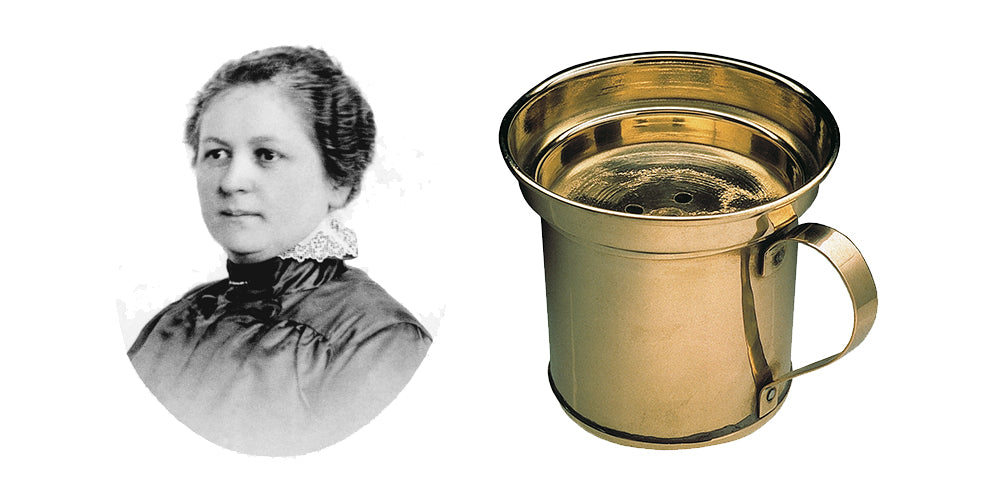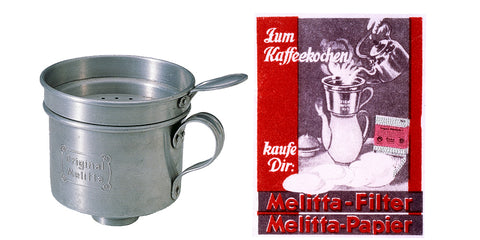From yuck to yum: A brief history of pour over coffee, featuring the inimitable Melitta Bentz

OK, history lesson comin' at you. Let’s talk about the history of the pour over, the brew method so many of us have enjoyed over the years but probably know very little about. Who invented the pour over as we know it today? The story goes that a German lady by the name of Melitta Bentz is credited with creating the pour over method way back in 1908. At that time, there were numerous percolation methods in existence, all of which created thick, muddy brews in a crude fashion. It’s noted throughout history that coffee was invariably bitter, a taste attribute that was inextricably linked to the roasting + brewing process. But that was soon to change.

Cafe culture began rapidly growing in central Europe in the mid-to-late 1800s, seemingly outpacing the unsophisticated brew methods du jour. Below are a few examples of early percolation devices circa 1860, all of which—much like modern a French Press—created unfiltered brews.

This type of coffee was inelegant and very heavy on the palate, often over-extracted and thus, bitter. I can’t speak to the coffee’s quality back then because I don’t have a time machine, but I would imagine that it wasn’t treated as meticulously as it is today (modern advantages like climate-controlled storage warehouses for raw coffee and electronic coffee roasters with touch screens come to mind). The coffee quality was probably rough around the edges and lent itself to harsh cups that “intellectuals” of the day chugged down in ornate Viennese cafes.
Years later, in the early 1900s when coffee became more common in households, Bentz, allegedly in defiance of the brew methodology of her day, decided to address this issue of bitter sludge people were calling “coffee”: enter the paper filter, and modern “dripper” or pour over brewer. This was a paradigm shift and major transformation in coffee. Bentz not only created a new brew method, but she introduced the concept of paper filtering to make coffee more palatable. Bye, bye bitterness. Before some hipster with a band t-shirt and half-a-year’s salary of tattoos could comment on “flavour clarity” and “mouthfeel,” Bentz was getting crafty in her garage with some tools and a bit of ingenuity. She punched holes in a brass pot and then employed notepad paper as a rather crude yet effective filtration method. This would have served to filter out some of the coffee oils and majority of the coffee grinds. I can only imagine what it must have been like to try coffee for the first time made that way, after only knowing the established percolation flavour profile that dominated. Like going from yuck to yum!

Now don’t get me wrong, I can enjoy the odd unfiltered coffee, be it French Press, espresso, or slurping from a cupping bowl. These methods of brewing coffee, when done well, can be exceedingly delicious and, at times, transcendent. But truth be told, I almost exclusively drink paper-filtered coffee, hence me wanting to write this blog post— I wanted to know more about my favourite brewing style and how it came to be. Maybe some of you already knew all this, or maybe some of you are saying to yourselves, “Melitta… isn’t that the crappy plastic dripper that my mom has tucked away in the cupboard?,” or, “Melitta… you mean the grocery store coffee filters?” Yes and yes. The “#4 filter” became associated with Melitta coffee drippers over the years, which fit into plastic or ceramic wedge drippers. The modern iteration of the brand is still largely a grocery store staple and not really associated with “specialty coffee,” better appreciated in a historical context. What’s left over from Bentz’s legacy of brewing is, besides an eponymous coffee dripper and paper filter, numerous brands who’ve adopted the filter geometry into their dripper designs.

Now I’m sad to say most coffee geeks out there overlook the #4 filter shape and corresponding wedge drippers on the market in favour of the cool kids on the block. They get out-shined by the HARIO V60, Kalita Wave, and Chemex brew methods. But the #4 filter can, in my opinion, produce a tasty cup of coffee with some careful brewing. They're slightly thicker than a Kalita Wave filter, and tend to retain as much oil and silt as a HARIO filter might. And the taste profile almost lands between the two: it doesn’t emphasize acidity like a V60 pour over might, nor does it highlight the sweetness of a Wave brew. It’s almost smack dab in the middle, and when it’s good, it’s reeeeeally good!

The #4 paper filter, in all its glory
Lately, I’ve been loving my Kalita 101 Ceramic dripper, which is made using Hasami porcelain— a traditional porcelain crafting method that originated four centuries ago in the town of Hasami, in the Nagasaki prefecture of Japan. This dripper is just so nice to look at, with an ivory white ceramic and shiny glaze, you can tell it’s high quality. This version is for brewing one cup, and it has a bigger cousin in a two cup version with black ceramic. I would recommend applying the same brewing methodology you would when making a V60 or Wave and adjusting as you go. The flow rate can be a bit slower than a V60, so you might want to grind slightly coarser.

A modern take on a classic, the Kalita 101 dripper in Hasami porcelain
But my favourite brew method that uses the paper filter of Melitta DNA is the Clever Coffee Dripper. I like it so much I wrote a blog post about it! Though not as pretty as the Kalita Hasami ceramic, this dripper has a major advantage of steep-and-release with its “clever” valve design. And we also sell some automatic brewers that employ the #4 filter— the Technivorn and Bonavita brands make machines with the same geometry baskets. This is no surprise given how standardized the #4 filter size has become with coffee makers over the years.

I’d definitely encourage you to experiment and see how you like the flavour profile of this type of filter compared to other brew methods out there. And if you already own a wedge-style brewer, maybe it’s high time you treat yourself to some gorgeous Hasami craftsmanship or grab a Clever Dripper for those mornings when you want a fuss-free cup. The best part is that the filters are interchangeable, so you can use them on both brewers. And if you’re a tree hugger, we got you covered— a very awesome person invented a reusable cloth filter for the #4 filter size.
How far we have come as a coffee drinking society, and yet, how traditional we still are. The way you make a pour over today is really not dissimilar to what they were doing over 100 years ago. Thankfully it’s now a bit more refined. But it’s only because of Melitta Bentz that we progressed in our coffee brewing at all, moving away from bitter and muddy cups to cleaner, sweeter brews. This is something I’m thankful for each morning. I raise my cup and salute you, Ms. Bentz!





